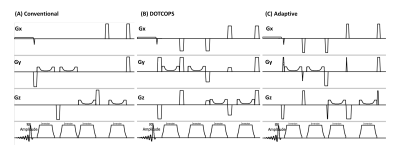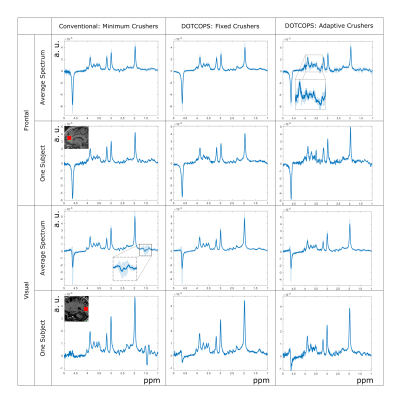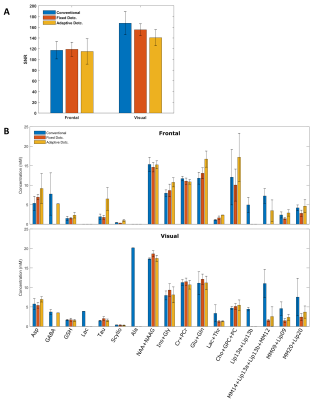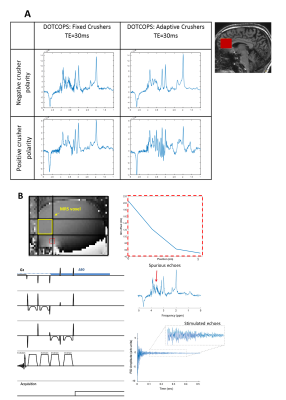2901
Optimal and efficient crushing for semi-LASER at 7T – a comparison1Radiology, University Medical Center Utrecht, Utrecht, Netherlands, 2Danish Research Centre for Magnetic Resonance, Centre for Functional and Diagnostic Imaging and Research, Copenhagen University Hospital Hvidovre, Hvidovre, Denmark
Synopsis
This study compares different crushing schemes for short-TE semi-LASER at 7T; minimal crushers, DOTCOPS and newly designed Adaptive crusher scheme. Maintaining a short echo time is traded for optimal spoiling of unwanted coherences.
Introduction
One of the important aspects of developing an MRS pulse sequence is to eliminate artifacts caused by unwanted excitations and spurious echoes1. This can be fulfilled by a combination of phase cycling and the proper design of gradient spoilers surrounding the refocusing pulses1,2. Recently, the DOTCOPS (Dephasing optimization through coherence order pathway selection) algorithm was introduced3, which numerically optimizes crusher schemes. Although DOTCOPS seems to be a very effective way of crushing, it comes with a cost; the minimum echo time is prolonged and the diffusion weighting increases due to the relatively high number of crusher gradients. In this study we compare crusher schemes for short echo time semi-LASER MRS at 7 Tesla. We used the DOTCOPS algorithm to design a new crushing scheme in which the crushers were optimized based on the area and orientation of the slice-selective gradients, and compared this to the originally proposed DOTCOPS crusher scheme and a conventional crusher scheme4.Methods
The DOTCOPS algorithm was run for semi-LASER with a 16-step cogwheel phase cycling. The relative crushing areas for our new crusher scheme (Adaptive; Figure 1C), original DOTCOPS crusher scheme (DOTCOPS; Figure 1B) and conventional crusher scheme (Conventional; Figure 1A) are reported in Table 1. In the Adaptive scheme, the slice selective gradients were considered to act as crushers, and their areas were taken into account when calculating the crusher areas. Therefore, the minimum echo-time is smaller than for the DOTCOPS crusher scheme.Experiments
We performed the measurements on a 7T MR scanner (Philips, Achieva, Best, NL) using a 32-channel receive-only 8-channel transmit coil (Nova Medical). We included 5 healthy subjects (Age: 25-38 years). A T1-weighted anatomical image (T1 3D TFE; 1mm3 isotropic voxel) was used for positioning two MRS voxels (2×2×2cm3) in the frontal and occipital lobe. MR spectra were acquired (semi-LASER, TE=36ms , TR=5s, NSA=32) using the schemes as presented in Figure 1. We selected the coronal voxel orientation, as this proved to be most prone to unwanted coherences. In addition, we evaluated the crushing performance of DOTCOPS and Adaptive with a TE of 30 ms with opposite crusher gradient polarity (z-direction) in a voxel (27cm3 isotropic) in the frontal lobe. To fit the DOTCOPS scheme within this TE, we reduced the crusher durations to 0.5 ms. The three crusher schemes were compared in terms of SNR (i.e., the amplitude of the NAA peak over the standard deviation of the noise between 10-11 ppm), quantification accuracy and b-values. Spectra were analyzed using LCModel5 using the unsuppressed water signal as a reference, only including concentrations quantified with a CRLB<30%.
Results
Figure 2 shows the spectra acquired with the three crushing schemes. For the voxel located in the frontal lobe, Conventional and DOTCOPS performed better than Adaptive in suppressing the unwanted signals, having more consistency across experiments. Spectra from Conventional are more prone to errors in the 1-2 ppm and 2.1-2.5 ppm range, which can also be seen in the voxel in the visual cortex. Here, spectra resulting from the Conventional scheme were contaminated with lipid signals from outside the voxel.The mean SNR was very comparable for the three crusher schemes (Figure 3A). An effective crushing scheme is of importance for estimating metabolites levels. Metabolites resonating in the regions with large variability are quantified very different between the schemes (Figure 3B). For instance, conventional crushers resulted in an incorrect quantification of lactate and alanine because of the outer volume lipid contamination.
When shortening the TE to its minimum of 30ms, the Adaptive scheme can be optimized with changing the polarity of the crushers. This results in better performance compared to the DOTCOPS scheme with fixed polarities (Figure 4).
The amount of diffusion weighting for Conventional, DOTCOPS and Adaptive is 7.88, 15.58 and 8.48 s/mm2 respectively.
Discussion and conclusions
We compared three crusher schemes for short TE semi-LASER at 7T: Conventional, DOTCOPS and Adaptive crushers. The least spurious echoes were observed in MR obtained with the DOTCOPS crusher scheme in both voxel positions. The Conventional scheme has the lowest b-value. However, the b-value for all schemes is low, and it is therefore unlikely that diffusion weighting led to significantly reduced metabolites amplitudes. On the other hand, diffusion weighting might lead to increased sensitivity to motion and pulsation, especially when the time between de- and re-phasing is large.In the Adaptive scheme, the crusher areas were adapted according to the area of the slice selective gradients. The adaptive scheme can be of use to reduce the echo time and keep good crushing performance in areas of relative high B0 inhomogeneity with the right choice for polarity of the crushers. As illustrated by Figure 2, a local B0 gradient can act as a rewinding gradient, causing stimulated echoes in the signal. Therefore, in further research it is recommended to acquire a B0 map prior to performing spectroscopy and use the information on local B0 field gradients in the crusher scheme design to avoid spurious echoes on an individual basis. In conclusion, there is an inherent tradeoff between optimal dephasing of unwanted coherences using large crusher gradients, and maintaining a short echo time in single-voxel MRS sequences.
Acknowledgements
We thank dr. Itamar Ronen for his help with determining the b-values of the different crusher schemes. Furthermore we like to thank Eurostars IMAGINE for financial support.References
1. Hennig J. The application of phase rotation for localized in vivo proton spectroscopy with short echo times. J. Magn. Reson. 1992; 96: 40–49.
2. Bain AD. Coherence levels and coherence pathways in NMR. A simple way to design phase cycling procedures. J Magn Reson. 1984;56:418–427.
3. Landheer K, Juchem C. Dephasing optimization through coherence order pathway selection (DOTCOPS) for improved crusher schemes in MR spectroscopy. Magn Reson Med. 2019; 81(4):2209-2222.
4. Boer VO, van Lier AL, Hoogduin JM, Wijnen JP, Luijten PR, Klomp DW. 7‐T (1) H MRS with adiabatic refocusing at short TE using radiofrequency focusing with a dual‐channel volume trans- mit coil. NMR Biomed. 2011;24:1038–1046.
5. Provencher SW. Estimation of metabolite concentrations from localized in vivo proton NMR spectra. Magn Reson Med. 1993;30(6):672-679.
Figures




